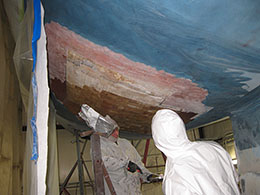At Skyway, we do that often. Our new fiberglass, paint and repair shop has dedicated vacuum and air extraction systems as well as radiant heat and high volume air compressor.
We have the ability to find and repair delamination, repaint and fair even the oldest boat. For our ‘relaminating’ process, we use vacuum bagging technology with a high powered vacuum, which allows us to laminate bigger pieces of wetted glass and more of them. This keeps the cost of repair down.
Our current project involves finding and removing some delaminated wet balsa core in a mature J-Boat with vinylester over glass,
Moisture on board
We will grind it to rough contour and begin the fairing process. After that, we will be covering the repairs with polyester gel coat, machine sand that to an 80 grit scratch, then apply Pettit’s PettitProtect epoxy based barrier coat, inking it and then fairing that down with a longboard. Then we will straighten the center line of the boat, recore the rudder and fair the keel.
 |
| Recoring the rudder |
When all the barrier coat is faired, we will spray it with VC Offshore.
The whole project will take about 4 weeks,
The fiberglass pieces we put up measured 76” x 53”. It took five of us working feverishly for 1 hour to get up three sheets of 1708 biaxial cloth (about 84 sq. ft.).
The fiberglass process went like this: First we dry wiped the side of the hull where the vacuum bag was to go. Then we wiped down the hull with a solvent to clean it for the tape. We measured the overall size of the balsa repair, cut the first fiberglass cloth to fit 4 inches outside of that all around and each succeeding piece 4 inches larger, cut the vacuum bagging film 10 inches bigger than that and taped the top edge film to the side of the boat, such that it hung down from approximately 10 inches above the repair.
We then cut the bleeder cloth slightly smaller than the bagging film and then cut the peel ply slightly smaller than that.
Since the repair was so massive, we kept the breather cloth and peel ply off to the side so it would not get tangled up in the wetting out and attachment process.
Next, came wetting out the balsa core on the boat and the cloth on the shop floor with the vinylester resin prior to putting it up on the boat, then bagging the whole thing.
 |
Wetting out the core |
 |
Wetting out the biax |
When the cloth was wet, we folded it into 8 inch horizontal folds (along the 76 “ axis) so we could safely carry it to the boat and start the adhesion process. This was a bit stressful, since the cloth was so heavy with the resin from the pre-wetting that it seemed like it might fall off the boat--it did not(if we used less resin, we found that the cloth would not stick to the boat, even though it was lighter).
Next comes adhesion. We put up the first sheet and rolled it out –no problem. The second sheet, being slightly bigger was a bit tougher to handle and required a couple additional sets of hands. We finally wrangled it under control and got it to stick in the proper place on the boat. The third piece actually went quite well until we were set to attach the peel ply-then it was a bit of chaos, since we could not find the cut sheet -- and the curing resin doesn’t care. We cut another piece of peel ply, stuck it up, rolled it, and put on the breather cloth. When that was all in place, we taped up the bagging film and fired up the vacuum.
4 hours later we had a new bottom.
Next comes—
- Grinding
- Fairing
- Gelcoat over patch
- Barrier coat
- Layout fluid
- Long board
- Refairing
- Spray VC Offshore
- Sand to 800 grit







Very good job! Thanks for the tips! I live in Greece and I own a small yacht. I recently found an experienced company in yacht painting https://reflection.com.gr/
ReplyDelete